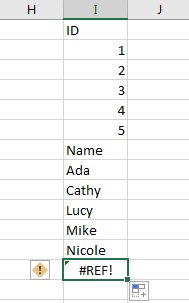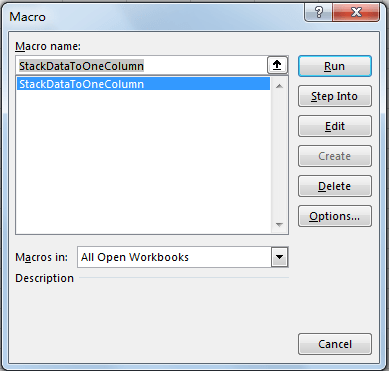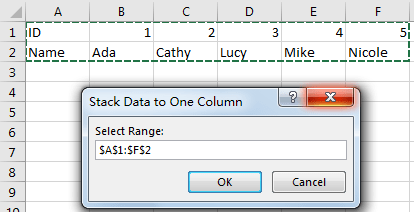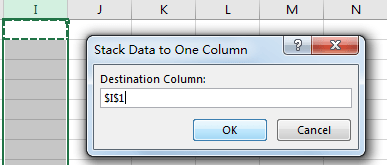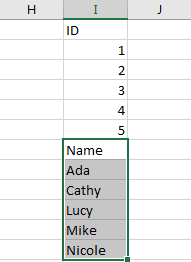Are you having difficulty merging two or more Excel columns? Knowing how to combine multiple columns in Excel without losing data is a handy time-saver that allows you to consolidate your data and make your sheet look neater.
First and foremost, you should know that there are multiple ways you can merge data from two or more columns in Excel. Before we get started exploring these different ways, let’s start with a key step that helps the process — how to merge cells in Excel.
If you want to combine Google Sheets data, you can do that easily using Layer. Layer is a free add-on that allows you to share sheets or ranges of your main spreadsheet with different people. On top of that, you get to monitor and approve edits and changes made to the shared files before they’re merged back into your master file, giving you more control over your data.
Install the Layer Google Sheets Add-On today and Get Free Access to all the paid features, so you can start managing, automating, and scaling your processes on top of Google Sheets!
How to Combine Multiple Cells or Columns in Excel Without Losing Data?
Once you have merging cells under your belt, learning how to combine multiple Excel columns into one column becomes intuitive.
Whether you’re learning how to combine two cells in Excel, or ten, one of the main benefits of merging is that the formulae don’t change. Here are the following ways you can combine cells or merge columns within your Excel:
Use Ampersand (&) to merge two cells in Excel
If you want to know how to merge two cells in Excel, here’s the quickest and easiest way of doing so without losing any of your data.
- 1. Double-click the cell in which you want to put the combined data and type =
- 2. Click a cell you want to combine, type &, and click the other cell you wish to combine. If you want to include more cells, type &, and click on another cell you wish to merge, etc.
- 3. Press Enter when you have selected all the cells you want to combine

While this is useful for quickly merging data into a single cell, the merged data will not be formatted. This can make data untidy or challenging to read in some instances (e.g. full names or addresses).
If you want to add punctuation or spaces (delimiters), follow the below steps. For this example, let’s put a comma and a space between the first and last name as you would see on a registration list:
- 1. Double-click the cell in which you want to put the merged data and type =
- 2. Click a cell you want to merge
- 3. This time, type &”, ”& before you click the next cell you want to merge. If you want to include more cells, type &”, ”& before clicking the next cell you want to merge, etc.
- 4. Press Enter when you have selected all the cells you want to combine

As you can see, now your merged data comes out in a neater format, with each piece of data appropriately separated.
Use the CONCATENATE function to merge multiple columns in Excel
This method is similar to the ampersand method, and also allows you to format your merged data. First, you need to use the CONCATENATE function to merge a row of cells:
- 1. Insert the =CONCATENATE function as laid out in the instructions above
- 2. Type in the references of the cells you want to combine, separating each reference with ,», «, (e.g. B2,», «,C2,», «,D2). This will create spaces between each value.
- 3. Press Enter
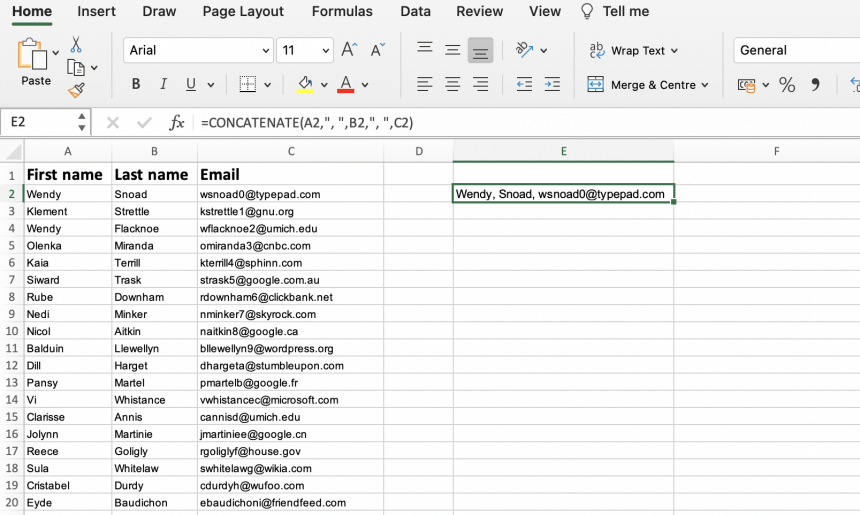
Now that you have successfully merged your cells, you can follow these simple steps to merge multiple columns:
- 1. Hover your mouse over the bottom-right corner of the merged cell you just created
- 2. When the cursor changes into a + symbol, drag your cursor as far down the column as you want and release it

Once you release the mouse, you should see that your merged cell has become a merged column, containing all of the data from your chosen columns.
*The CONCAT function is another formula used for combining data from different cells. However, it is limited to two references and does not allow you to include delimiters.
Use the TEXTJOIN function to merge multiple columns in Excel
This method works only with Excel 365, 2021, and 2019. As you can probably tell, this function is helpful when you want to combine two or more text cells in Excel.
The following steps will show you how to use the TEXTJOIN function, once again using the comma and space combination to create your first merged cell:
- 1. Double-click the cell in which you want to put the combined data
- 2. Type =TEXTJOIN to insert the function
- 3. Type “, ”,TRUE, followed by the references of the cells you want to combine, separating each reference with a comma (the role of TRUE is to disregard empty cells you may have input)
- 4. Press Enter

In order to create the rest of your combined column, use the drag-and-drop steps listed below:
- 1. Hover your mouse over the bottom-right corner of the merged cell you just created
- 2. When the cursor changes into a + symbol, drag your cursor as far down the column as you want and release it.

Now your columns of data have successfully merged into your new column.
The Beginner’s Guide to Excel Version Control
Discover what Excel version control is, the version control features Excel has to offer, and how to use them to share, merge, and review Excel changes
READ MORE

Use the INDEX formula to stack multiple columns into one column in Excel
Let’s say you want to create a stack of data from your multiple columns, rather than create a single cell. You can easily do this across multiple cells and columns within your spreadsheet using the INDEX formula:
- 1. Select all of the cells containing your data
- 2. Type in a name for this group of data in the “Name Box” (box located to the left side of the formula bar). In this example, I’ve named the data “_my_data”
- 3. Select an empty cell in your Excel sheet where you want your stacked data to be located. Input the following INDEX formula (remember to substitute with your data name):
=INDEX(_my_data,1+INT((ROW(A1)-1)/COLUMNS(_my_data)),MOD(ROW(A1)-1+COLUMNS(_my_data),COLUMNS(_my_data))+1)
-
4. The first value from your data range should appear. Hover over the cell until the cursor changes into a + symbol, and drag your cursor as far down until you receive a #REF! value (this signals the end of your data set)
Other ways to combine multiple columns in Excel: Notepad and VBA script
There are two other ways you can combine multiple columns in Excel. These are often more time-consuming, and use other tools as part of the process. However, they may be more helpful for users who wish to avoid using Excel formulae.
Use Notepad to merge multiple columns in Excel
You can use Notepad to extract, format, and replace your data from multiple columns in your Excel. For this, you need to copy and paste each column from your Excel sheet into a Notepad file. Then, use the Replace function to add commas between each value. Once finished, you can copy and paste your formatted data back into your Excel.
Use VBA script to combine two or more columns in Excel
As an alternative to the INDEX function stacking method, you can use VBA script. Simply right-click and select “View code” within your Excel, and copy and paste the code in a new window. Press “F5” to run the code and create a Macro. You can then apply this to your Excel by selecting your data range and applying it to your destination column.
Want to Boost Your Team’s Productivity and Efficiency?
Transform the way your team collaborates with Confluence, a remote-friendly workspace designed to bring knowledge and collaboration together. Say goodbye to scattered information and disjointed communication, and embrace a platform that empowers your team to accomplish more, together.
Key Features and Benefits:
- Centralized Knowledge: Access your team’s collective wisdom with ease.
- Collaborative Workspace: Foster engagement with flexible project tools.
- Seamless Communication: Connect your entire organization effortlessly.
- Preserve Ideas: Capture insights without losing them in chats or notifications.
- Comprehensive Platform: Manage all content in one organized location.
- Open Teamwork: Empower employees to contribute, share, and grow.
- Superior Integrations: Sync with tools like Slack, Jira, Trello, and more.
Limited-Time Offer: Sign up for Confluence today and claim your forever-free plan, revolutionizing your team’s collaboration experience.
Conclusion
As you can see, combining multiple columns is easy in Excel. Whether you’re combing multiple Excel files, or columns and cells, there are a variety of ways that cater to different users, depending on their technical abilities or needs.
As a result, not only can you format your Excel into a cohesive and seamless spreadsheet, but also save time and optimize your productivity when evaluating, managing, or sharing important data. Once you know how to combine multiple columns in Excel into one column, combining or merging your data can become one quick and simple task.
Are you tired of having your data spread out across multiple columns, making it difficult to analyze and understand? It can be overwhelming to have to constantly switch back and forth between columns, hunting for the information you need. This post will show you how to stack data from multiple columns to one column in Microsoft Excel Spreadsheet.
This article will introduce you the two methods. After reading the article below, you will find the two ways are verify simple and convenient to operate in excel.
In previous article, I have shown you the method to split data from one long column to multiple columns by VBA and Index function.
For example, see the initial table below:
And we want reverse data into one column and make it looks like:
Now we can follow below two methods to make it possible. Let’s start it.
Table of Contents
- 1. Stack Data in Multiple Columns into One Column by Formula
- 2. Stack Data in Multiple Columns into One Column by VBA
- 3. Merge Cells into One in Excel
- 4. Combine two columns in excel without losing data
- 5. Combine 2 Columns with a Space
- 6. Append Columns in Excel
- 7. Conclusion
- 8. Related Functions
Step 1: Select range A1 to F2 (you want to do stack), in Name Box, enter a valid name like Range, then click Enter.
Step 2: In any cell you want to locate the first cell of destination column, enter the formula
=INDEX(Range,1+INT((ROW(A1)-1)/COLUMNS(Range)),MOD(ROW(A1)-1+COLUMNS(Range),COLUMNS(Range))+1).Please be aware that you have to replace ‘Range’ in this formula to your defined name in Name Box.
Step 3: Click Enter. Verify that ‘ID’ (the value in the first cell of selected range) is displayed properly.
Step 4: Drag the fill handle to fill I column. Verify that data in previous initial location is reversed to one column properly.
Note:
If you drag the fill handle to cells extend selected range cell number, error will be displayed in redundant cell.
2. Stack Data in Multiple Columns into One Column by VBA
Step 1: On current visible worksheet, right click on sheet name tab to load Sheet management menu. Select View Code, Microsoft Visual Basic for Applications window pops up.
Or you can enter Microsoft Visual Basic for Applications window via Developer->Visual Basic.
Step 2: In Microsoft Visual Basic for Applications window, click Insert->Module, enter below code in Module1:
Sub StackDataToOneColumn()
Dim Rng1 As Range, Rng2 As Range, Rng As Range
Dim RowIndex As Integer
Set Rng1 = Application.Selection
Set Rng1 = Application.InputBox("Select Range:", "StackDataToOneColumn", Rng1.Address, Type:=8)
Set Rng2 = Application.InputBox("Destination Column:", "StackDataToOneColumn", Type:=8)
RowIndex = 0
Application.ScreenUpdating = False
For Each Rng In Rng1.Rows
Rng.Copy
Rng2.Offset(RowIndex, 0).PasteSpecial Paste:=xlPasteAll, Transpose:=True
RowIndex = RowIndex + Rng.Columns.Count
Next
Application.CutCopyMode = False
Application.ScreenUpdating = True
End Sub
Step 3: Save the codes, see screenshot below. And then quit Microsoft Visual Basic for Applications.
Step 4: Click Developer->Macros to run Macro. Select ‘StackDataToOneColumn’ and click Run.
Step 5: Stack Data to One Column dialog pops up. Enter Select Range $A$1:$F$2. Click OK. In this step you can select the range you want to do stack.
Step 6: On Stack Data to One Column, enter Destination Column $I$1. Click OK. In this step you can select the first cell from destination range you want to save data.
Step 7: Click OK and check the result. Verify that data is displayed in one column properly. The behavior is as same as the result in method 1 step# 4.
3. Merge Cells into One in Excel
To merge or consolidate cells in Microsoft Excel, follow these steps:
Step 1: Select the cells you want to merge.
Step 2: Right-click on the selected cells and choose “Merge Cells” from the context menu.
Step 3: Alternatively, you can click on the “Merge & Center” button in the “Alignment” section of the “Home” tab on the ribbon.
4. Combine two columns in excel without losing data
To combine two columns in Microsoft Excel without losing data, you can use the following formula:
Step 1: In a new column C1, enter the following formula:
=A1 & B1If you want to combine data from two or multiple cells in Excel, you can also use this formula.
Step 2: Press Enter to apply the formula.
Step 3: Drag the formula down to the end of the data in the columns.
The formula uses the & operator to concatenate the contents of two cells. In this example, the formula combines the contents of cells A2 and B2 into a single cell. By dragging the formula down, you can combine the contents of all the cells in the two columns.
You can also use the CONCATENATE function to combine columns, which works in a similar manner. The formula would look like this:
=CONCATENATE(A1, B1).5. Combine 2 Columns with a Space
If you want to combine two columns with a space between them, you can use the following formula:
=A1 & " " & B1In this example, the formula combines the contents of cells A1 and B1 into a single cell, separated by a space. By dragging the formula down, you can combine the contents of all the cells in the two columns.
6. Append Columns in Excel
If you want to append two columns in Microsoft Excel, just follow these steps:
Step 1: Select the first column of data that you want to append.
Step 2: Right-click on the selected cells and choose “Copy” from the context menu.
Step 3: Select the second column of data that you want to append, and right-click on the first cell in the column.
Step 4: Choose “Insert Copied Cells” from the context menu.
This will insert a copy of the first column of data after the second column, effectively appending the two columns.
7. Conclusion
Stacking data from multiple columns into one is a useful operation in Microsoft Excel when you need to combine and analyze data from different sources. The process can be easily achieved by using the built-in functions such as the & operator or the CONCATENATE function, which allow you to concatenate the contents of multiple cells into one.
Hope you can like this post.
- Excel INDEX function
The Excel INDEX function returns a value from a table based on the index (row number and column number)The INDEX function is a build-in function in Microsoft Excel and it is categorized as a Lookup and Reference Function.The syntax of the INDEX function is as below:= INDEX (array, row_num,[column_num])… - Excel ROW function
The Excel ROW function returns the row number of a cell reference.The ROW function is a build-in function in Microsoft Excel and it is categorized as a Lookup and Reference Function.The syntax of the ROW function is as below:= ROW ([reference])…. - Excel MOD function
he Excel MOD function returns the remainder of two numbers after division. So you can use the MOD function to get the remainder after a number is divided by a divisor in Excel. The syntax of the MOD function is as below:=MOD (number, divisor)…. - Excel INT function
The Excel INT function returns the integer portion of a given number. And it will rounds a given number down to the nearest integer.The syntax of the INT function is as below:= INT (number)… - Excel COLUMNS function
The Excel COLUMNS function returns the number of columns in an Array or a reference.The syntax of the COLUMNS function is as below:=COLUMNS (array)….
I have multiple lists that are in separate columns in excel. What I need to do is combine these columns of data into one big column. I do not care if there are duplicate entries, however I want it to skip row 1 of each column.
Also what about if ROW1 has headers from January to December, and the length of the columns are different and needs to be combine into one big column?
ROW1| 1 2 3
ROW2| A D G
ROW3| B E H
ROW4| C F I
should combine into
A
B
C
D
E
F
G
H
I
The first row of each column needs to be skipped.
asked Jun 4, 2010 at 20:40
Try this. Click anywhere in your range of data and then use this macro:
Sub CombineColumns()
Dim rng As Range
Dim iCol As Integer
Dim lastCell As Integer
Set rng = ActiveCell.CurrentRegion
lastCell = rng.Columns(1).Rows.Count + 1
For iCol = 2 To rng.Columns.Count
Range(Cells(1, iCol), Cells(rng.Columns(iCol).Rows.Count, iCol)).Cut
ActiveSheet.Paste Destination:=Cells(lastCell, 1)
lastCell = lastCell + rng.Columns(iCol).Rows.Count
Next iCol
End Sub
answered Jun 5, 2010 at 13:15
Alex PAlex P
12.2k5 gold badges51 silver badges69 bronze badges
3
You can combine the columns without using macros. Type the following function in the formula bar:
=IF(ROW()<=COUNTA(A:A),INDEX(A:A,ROW()),IF(ROW()<=COUNTA(A:B),INDEX(B:B,ROW()-COUNTA(A:A)),IF(ROW()>COUNTA(A:C),"",INDEX(C:C,ROW()-COUNTA(A:B)))))
The statement uses 3 IF functions, because it needs to combine 3 columns:
- For column A, the function compares the row number of a cell with the total number of cells in A column that are not empty. If the result is true, the function returns the value of the cell from column A that is at row(). If the result is false, the function moves on to the next IF statement.
- For column B, the function compares the row number of a cell with the total number of cells in A:B range that are not empty. If the result is true, the function returns the value of the first cell that is not empty in column B. If false, the function moves on to the next IF statement.
- For column C, the function compares the row number of a cell with the total number of cells in A:C range that are not empty. If the result is true, the function returns a blank cell and doesn’t do any more calculation. If false, the function returns the value of the first cell that is not empty in column C.
TylerH
20.6k64 gold badges76 silver badges97 bronze badges
answered Dec 3, 2014 at 8:25
CristinaPCristinaP
3063 silver badges6 bronze badges
0
Not sure if this completely helps, but I had an issue where I needed a «smart» merge. I had two columns, A & B. I wanted to move B over only if A was blank. See below. It is based on a selection Range, which you could use to offset the first row, perhaps.
Private Sub MergeProjectNameColumns()
Dim rngRowCount As Integer
Dim i As Integer
'Loop through column C and simply copy the text over to B if it is not blank
rngRowCount = Range(dataRange).Rows.Count
ActiveCell.Offset(0, 0).Select
ActiveCell.Offset(0, 2).Select
For i = 1 To rngRowCount
If (Len(RTrim(ActiveCell.Value)) > 0) Then
Dim currentValue As String
currentValue = ActiveCell.Value
ActiveCell.Offset(0, -1) = currentValue
End If
ActiveCell.Offset(1, 0).Select
Next i
'Now delete the unused column
Columns("C").Select
selection.Delete Shift:=xlToLeft
End Sub
answered Jun 4, 2010 at 20:49
Function Concat(myRange As Range, Optional myDelimiter As String) As String
Dim r As Range
Application.Volatile
For Each r In myRange
If Len(r.Text) Then
Concat = Concat & IIf(Concat <> "", myDelimiter, "") & r.Text
End If
Next
End Function
answered Jun 4, 2010 at 21:01
Mark BakerMark Baker
208k31 gold badges340 silver badges383 bronze badges
Very often we need to combine several columns into one when using Microsoft Excel. A powerful feature called “merge & center” enables us to merge two cells together. “Merge across” enables us to merge range across different rows. However, there isn’t any feature nor function that stack multiple columns into one column.
If you have the following questions, I suggest you reading this until the end.
- How to delete hidden rows in Excel?
- How to delete invisible rows in Excel?
- How to delete hidden rows from entire Excel workbook?
In this article, I will show you how to stack multiple columns into one column. I will show you how to stack multiple column into a single vertical column from up to down and from left to right.
You might also be interested in Excel Split Long Text into Short Cell Without Splitting Word.
Stack Multiple Columns into One Column vertically (Up to down)
Here is an example to show you how to stack Multiple Columns into One Column vertically.
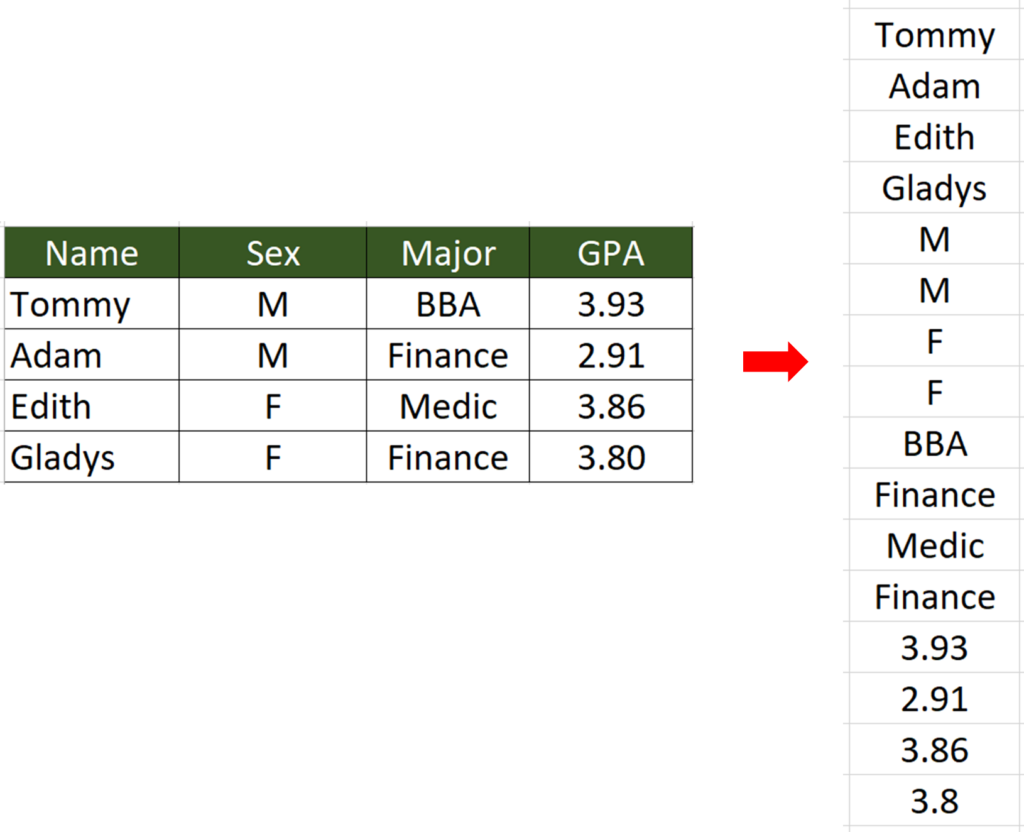
What we would like to do
To stack multiple columns into one column, from top to bottom and then from left to right
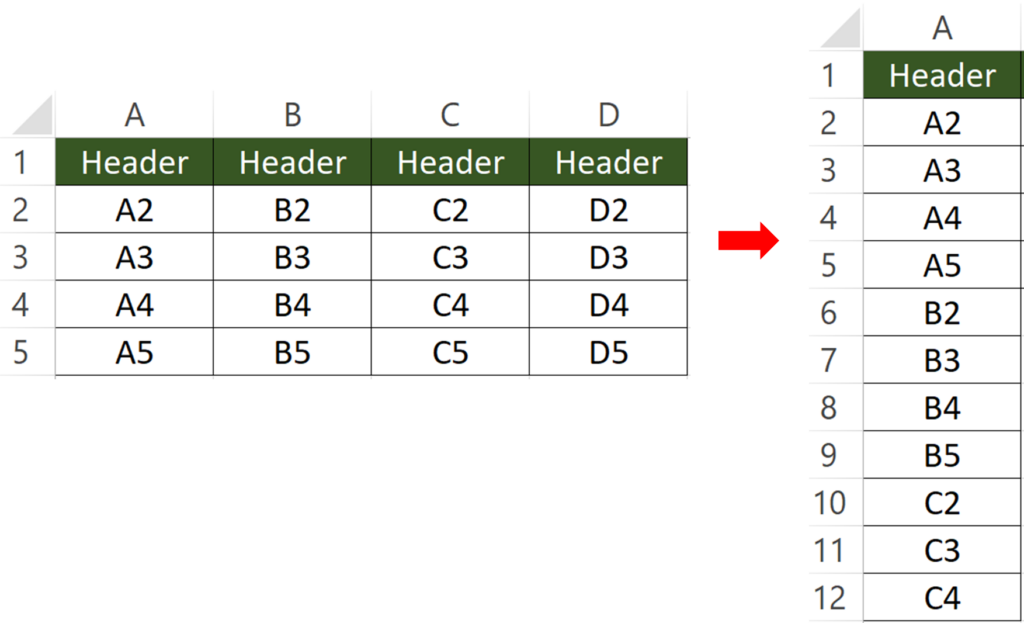
You might also be interested in How to prevent duplicate entries in Excel?
Step 1: Enter this formula right below the end of the first column
Formula
=the_first_cell_of_the_second_column
In the example, the first column ends at cell A5. So, I input the formula into cell A6.
It is such a neat formula, right?
I have seen people done this with a much complicated formula.
I would say
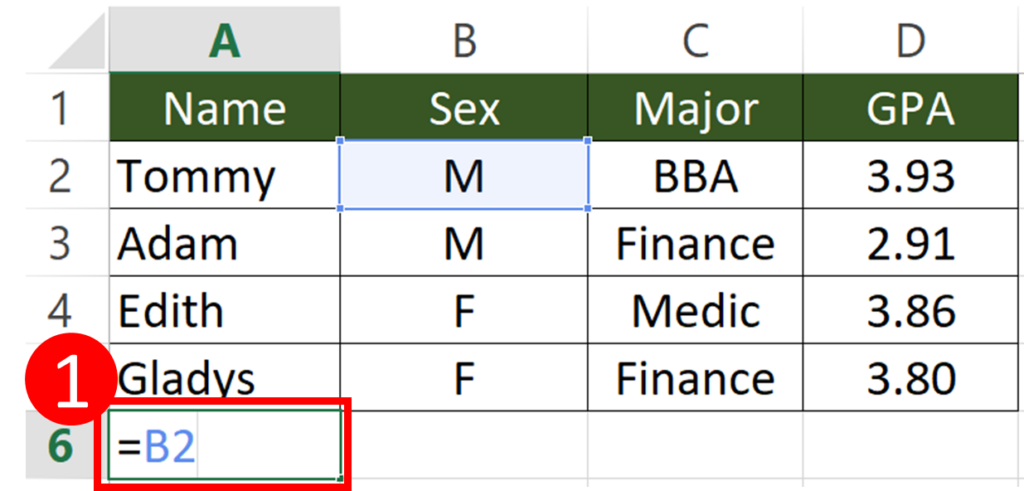
You may wonder why cell B2 instead of cell B1 is put here.
This is because I don’t want to include row 1 in my final results. If that is what you want, you can input B1 instead of B2.
Let me show you how the end result would look like if I have put B1 instead.

Step 2: Hover on the lower right corner of the cell and drag it until the last column
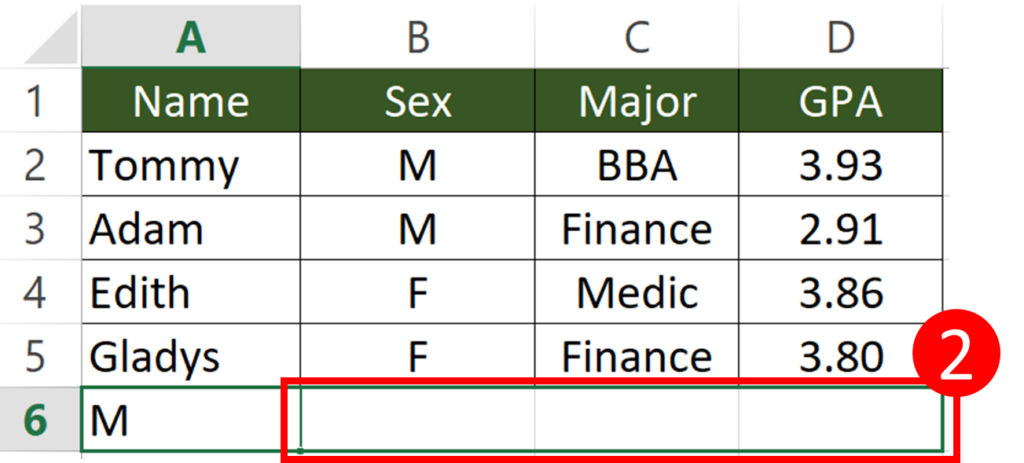
When you put your mouse pointer over the lower right edge of the cell, you will see a small black plus sign.
Click the black plus sign and drag it over to the last column (column D in this case) and don’t release your finger until you reach the last column.
This feature is called Autofill. It automatically fills in a series of cells for you.
When you do this, make sure you have selected the cell. Otherwise the small black plus sign won’t appear.
The table should look like this when you release the left mouse button.

Step 3: Hover on the lower right corner of the cell and drag it until the last row
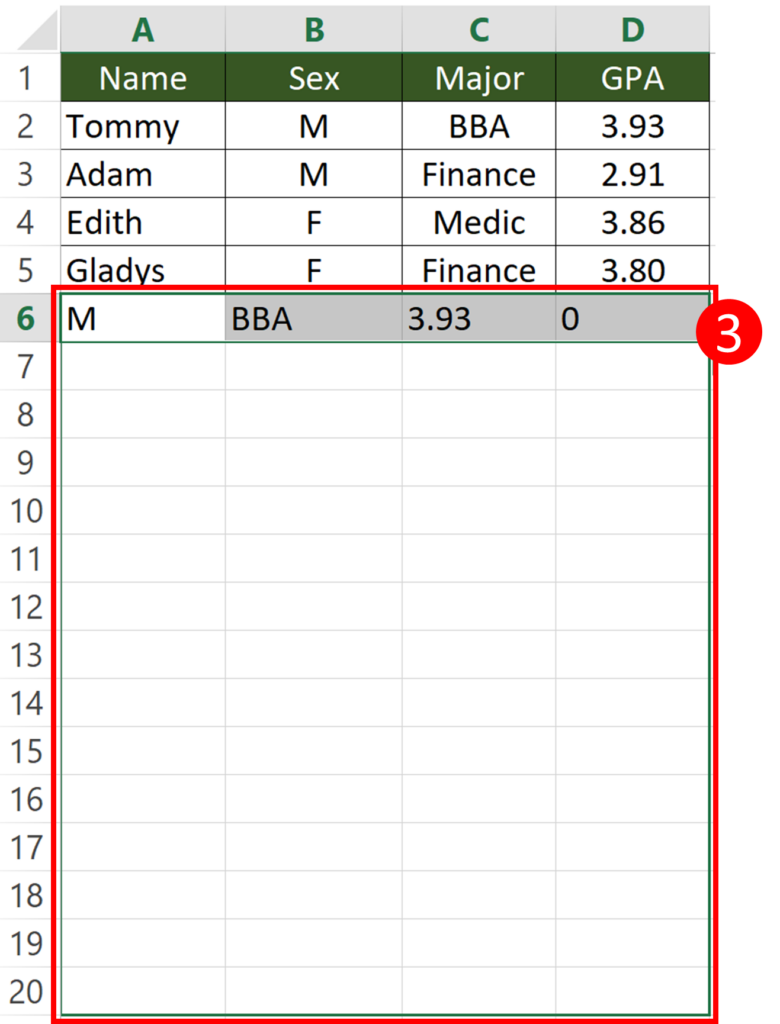
Step 3 is very similar to step 2.
Once again, we will need to make use of the Autofill feature in Excel.
The only thing that is different is that this time we are going to drag the small plus sign downwards.
In the previous step, we dragged the small plus sign rightwards until the last columns.
This time, we will need to drag the sign downwards until the last row.
You may wonder which row to drag until.
Usually, I just follow my heart. I will drag this down randomly and stop at a point where I think is right.
If I dragged more than I need, the extra rows will contain a “0”. I just delete them.
If you drag too much, you don’t need to worry for now. We will fix that later.

The table should look like this when you release the left mouse button.
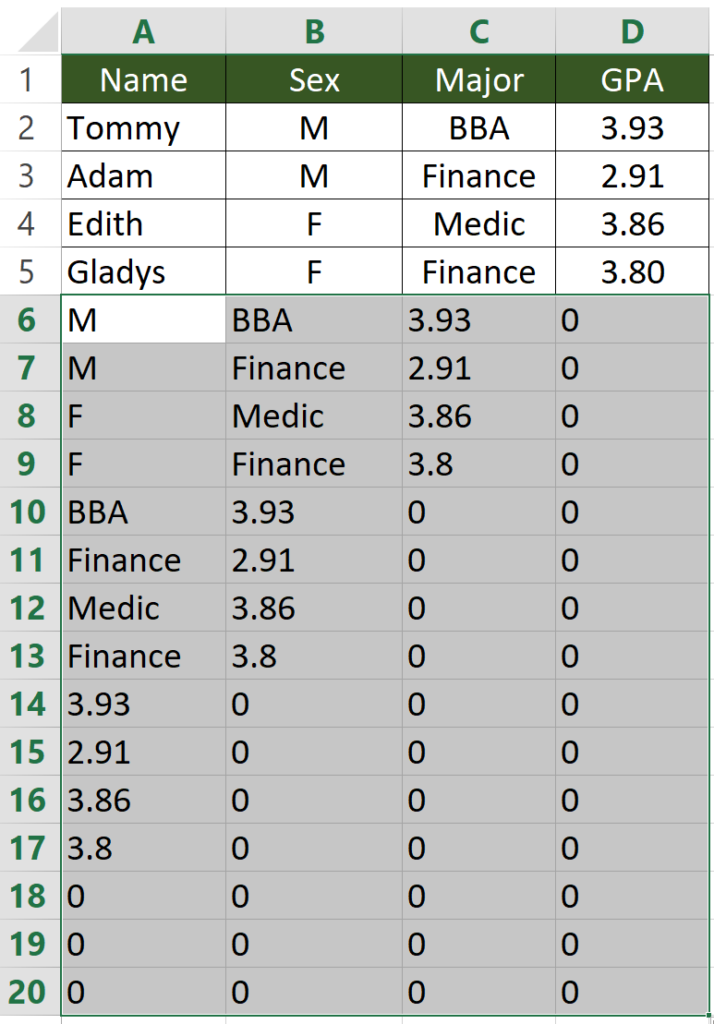
Step 4: Copy and paste values

Step 5: “Home” > “Find & Select” > “Replace”

Step 6: Input “0” in “Find what” field > empty the “Replace with” field > Press “Replace All”
Here we will replace all “0” with nothing.
Make sure the “Replace with” field is empty. Not even space is allowed.
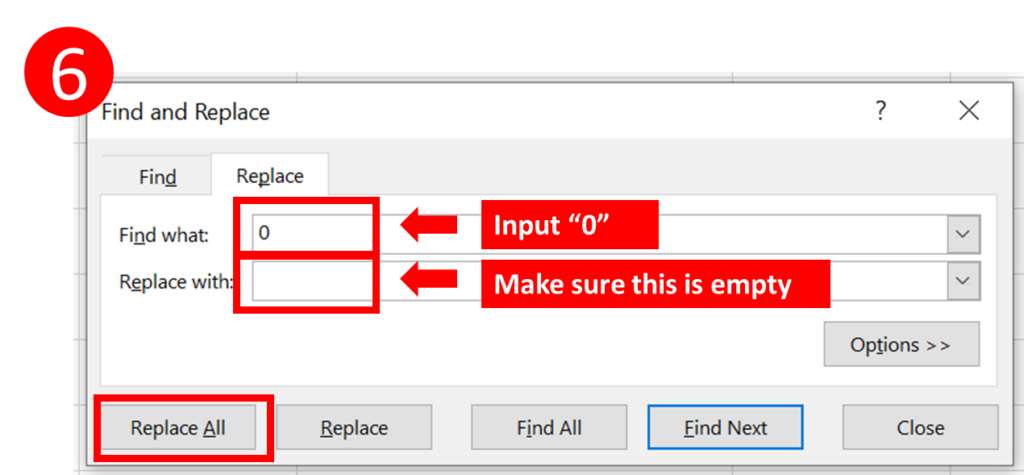
After pressing “Replace All”, you will see a pop up window telling you how many replacements have been made.

Then you can close the replace window by pressing Esc key.

The table should look like this now. All we have to do is to delete the extra data.
In this case, cell B6 to cell B17 and cell C6 to C9 are redundant.
Step 7: Select the redundant cells and click the right mouse button > Press “Delete” > Press “OK”

Result

You might also be interested in 6 Ways To Converting Text To Number Quickly In Excel
Stack Multiple Columns into One Column by formula (left to right)
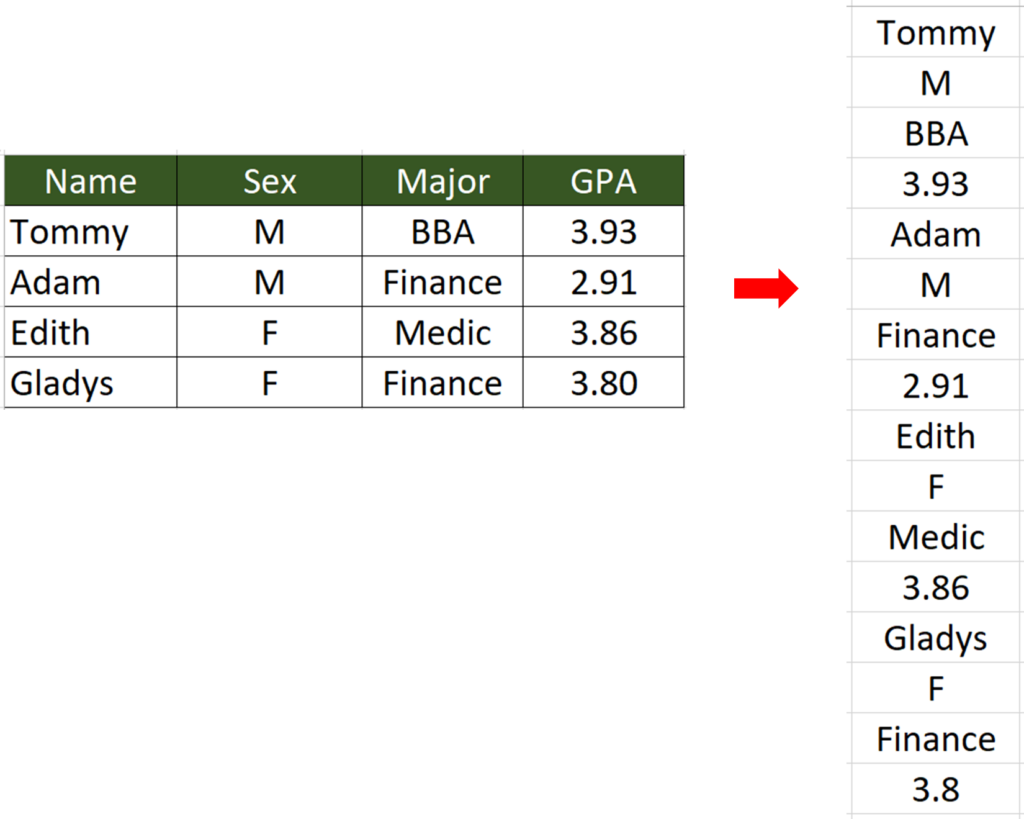
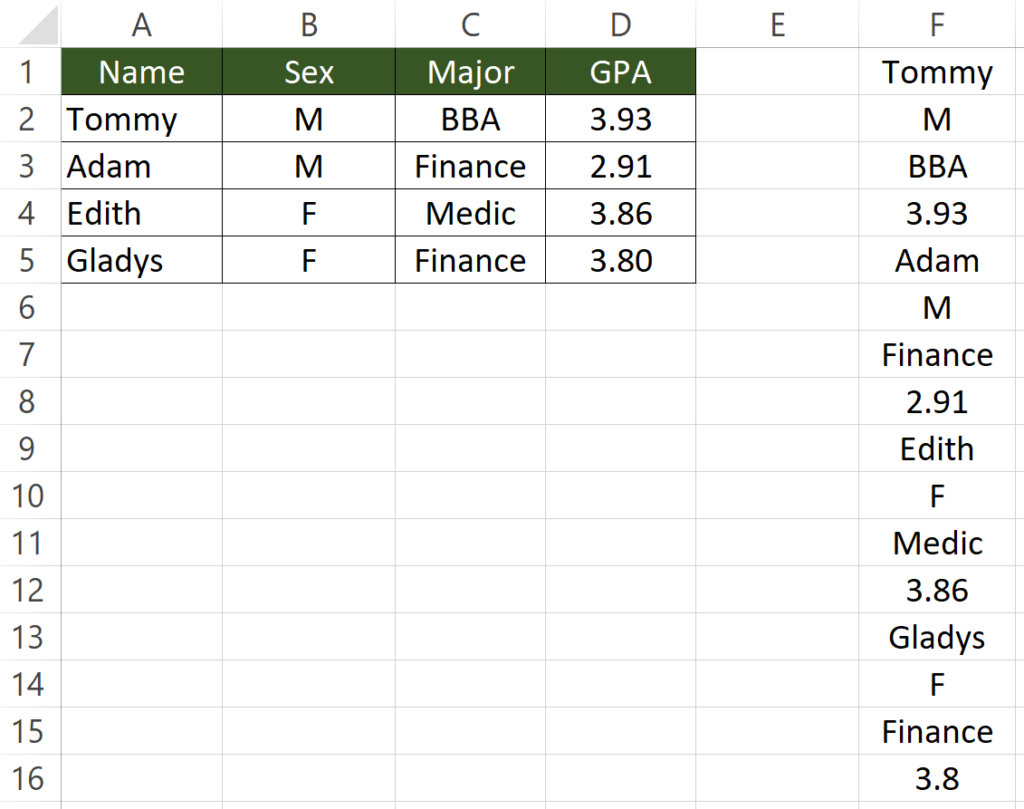
All we need is a formula.
Formula in Cell F1
=INDEX($A$2:$D$5,1+INT((ROW(A1)-1)/COLUMNS($A$2:$D$5)),MOD(ROW(A1)-1+COLUMNS($A$2:$D$5),COLUMNS($A$2:$D$5))+1)
How to use the formula
=INDEX(Original_table,1+INT((ROW(A1)-1)/COLUMNS(Original_table)),MOD(ROW(A1)-1+COLUMNS(Original_table),COLUMNS(Original_table))+1)
In the above example, the table starts from cell A2 and stop at cell D5. So we will put A2:D5 as the Cell_range. Make sure you lock the cell (Add dollar sign to each cell). The shortcut to lock cells is to press F4.
We are almost there.
Just make sure you got the formula in the first cell right. Then you can copy the cell down until you saw a #REF error.

The formula may seem a bit complicated at the first glance but it is not.
It doesn’t require much effort to edit the formula.
Stack Multiple Columns into One Column by VBA (left to right)
**Read How to Insert & Run VBA code in Excel – VBA101 if you forget how to insert VBA code in Excel.

Sub StackColumnIntoOne()
Dim Tablerng, Destinationrng, Rng As Range
'Get table range by inputbox
Set Tablerng = Application.InputBox(Prompt:="Please select the table range", Type:=8)
'Get destination range by inputbox
Set Destinationrng = Application.InputBox(Prompt:="Please select the Destination cell", Type:=8)
For Each Rng In Tablerng.Rows
'Copy each cell inside the table
Rng.Copy
'Paste them into the destination column
Destinationrng.Offset(RowIndex, 0).PasteSpecial Paste:=xlPasteAll, Transpose:=True
RowIndex = RowIndex + Rng.Columns.Count
Next
End Sub
What this VBA code does
This VBA code does the exact same thing as the How to Check/Test if Sheets Exist in Excel?
How To List All Worksheets Name In A Workbook
How to Unpivot or Reverse Pivot in Excel
You might also be interested in How To Remove Digits After Decimal In Excel?
Hungry for more useful Excel tips like this? Subscribe to our newsletter to make sure you won’t miss out on any of our posts and get exclusive Excel tips!
=OFFSET($A$2,CEILING(ROW(A2)/COLUMNS(A2:B5),1)-1,MOD(ROW(A2)-1+COLUMNS(A2:B5),2))
$A$2 = fixed cell; A2 = dynamic cell; A2:B5 = data range
Check below for a detailed explanation with pictures and how to use formulas in Excel and Google Sheets.
Combine multiple columns into one single column in Excel
Combine multiple columns into one single column in Excel
How to combine multiple columns into one single column in Excel?
COMBINE MULTIPLE COLUMNS INTO ONE SINGLE COLUMN — EXCEL FORMULA AND EXAMPLE
COMBINE MULTIPLE COLUMNS INTO ONE SINGLE COLUMN — EXCEL FORMULA AND EXAMPLE
=OFFSET($A$2,CEILING(ROW(A2)/COLUMNS(A2:B5),1)-1,MOD(ROW(A2)-1+COLUMNS(A2:B5),2))
-
-
$A$2 = fixed cell, where data starts
-
A2 = dynamic cell where data starts
-
2 = number of columns
-
A2:B5 = data range, you can also use columns instead of a range
-
=OFFSET($A$2,ROUNDUP(ROWS($1:1)/2,0)-1,MOD(ROWS($1:1)-1,2))
-
$A$2 = fixed cell, where data starts
-
$1:1 = fixed column and dynamic row
-
2 = number of columns
💡 Download the Excel file used in this exercise here. It’s much easier and simpler to combine in Google Sheets. The example below and recommended to do it in Google Sheets
Combine multiple columns into one single column in Google Sheets
Combine multiple columns into one single column in Google Sheets
How to combine multiple columns into one single column in Google Sheets?
COMBINE MULTIPLE COLUMNS INTO ONE SINGLE COLUMN — GOOGLE SHEETS FORMULA AND EXAMPLE
COMBINE MULTIPLE COLUMNS INTO ONE SINGLE COLUMN — GOOGLE SHEETS FORMULA AND EXAMPLE
=TRANSPOSE(SPLIT(TEXTJOIN(«,»,1,A2:B5),«,»))
-
A2:B5 = data cell, you can also use columns instead of a range and the empty cell will be ignored as is shown in the above example
💡 Download the Excel file used in this exercise here. It’s much easier and simpler to combine in Google Sheets. The example below and recommended to do it in Google Sheets
Coming | Subscribe here for the custom Excel/Sheets formulas E-book (PDF) >








